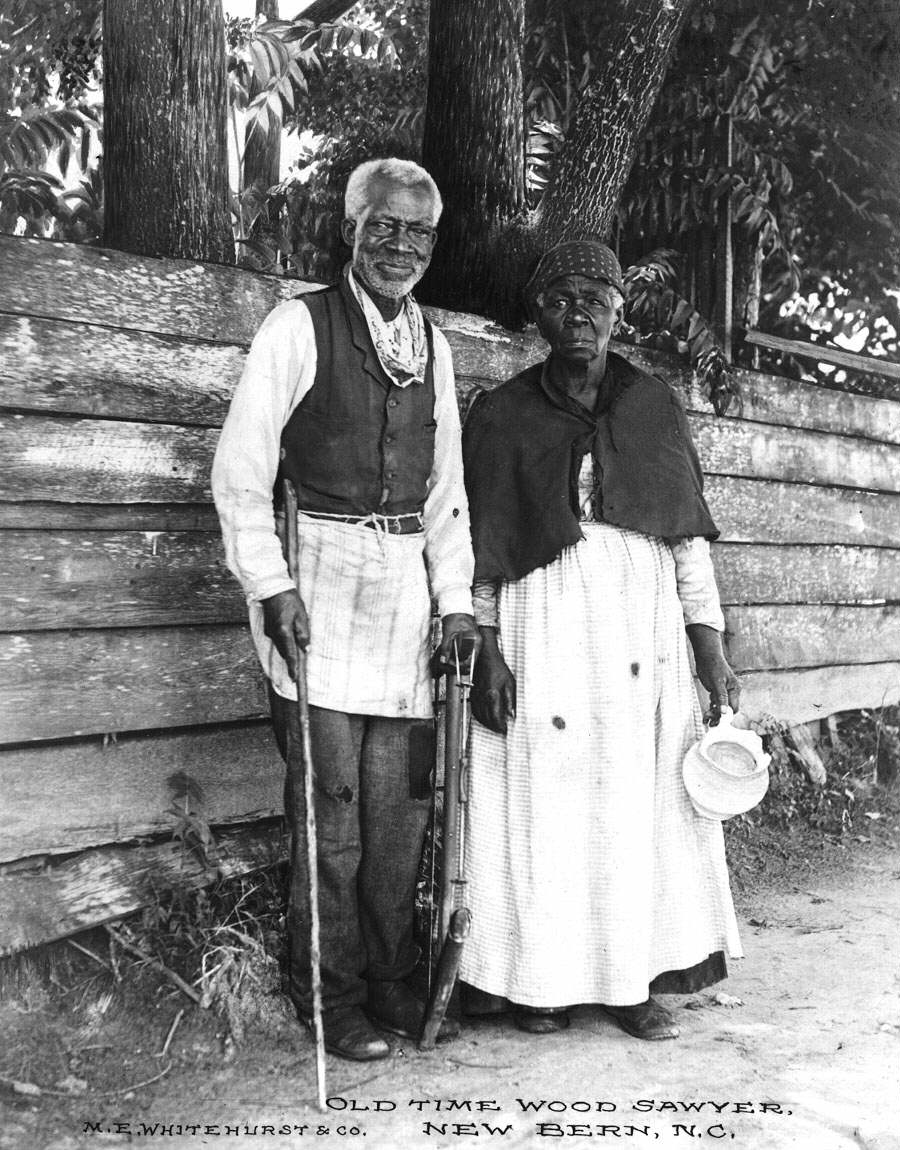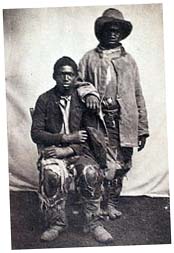
From Learn North Carolina, The life of a slave: From Slavery in North Carolina," provided by the University of North Carolina (UNC) Libraries. -- Daily life for a slave in North Carolina was incredibly difficult. Slaves, especially those in the field, worked from sunrise until sunset. Even small children and the elderly were not exempt from these long work hours. Slaves were generally allowed a day off on Sunday, and on infrequent holidays such as Christmas or the Fourth of July.
During their few hours of free time, most slaves performed their own personal work. The diet supplied by slaveholders was generally poor, and slaves often supplemented it by tending small plots of land or fishing. Many slave owners did not provide adequate clothing, and slave mothers often worked to clothe their families at night after long days of labor. One visitor to colonial North Carolina wrote that slaveholders rarely gave their slaves meat or fish, and that he witnessed many slaves wearing only rags. Although there were exceptions, the prevailing attitude among slave owners was to allot their slaves the bare minimum of food and clothing; anything beyond that was up to the slaves to acquire during their very limited time away from work.

Goose Creek Plantation in North Carolina.
Shelter provided by slave owners was also meager. Many slaves lived in small stick houses with dirt floors, not the log slave cabins often depicted in books and films. These shelters had cracks in the walls that let in cold and wind, and had only thin coverings over the windows. Again, slave owners supplied only the minimum needed for survival; they were primarily concerned with keeping their financially valuable slaves alive and working rather than providing for their comfort, health, or safety.
One area of their lives in which slaves were able to exercise some autonomy from their masters was creating a family. Slave owners felt it was to their advantage to allow slaves to marry, because any children from the marriage would add to their wealth. According to law, a child took on the legal status of its mother; a child born to a slave mother would in turn become a slave, even if the father was free. Slaves usually had to ask permission from their masters to marry, however, and slave marriages had no legal protection. Masters could break up marriages and separate families as they wished.

The slave trade in North Carolina separated countless husbands, wives, parents and children. On the whole, slaveholders cared little about the kindred bonds of slaves, and tore families apart by selling slaves for profit.
Because the large plantations of the Lower South needed more slaves than the smaller farms of North Carolina, it was not uncommon for slaves in the state to be sold to slave traders who took them south to Georgia, South Carolina, Mississippi, Louisiana or Alabama. Once a family member was sold and taken to the Deep South, they became almost impossible to locate or contact.


New Bern, North Carolina
Slaves had no way to legally protest their masters’ harsh treatment and abuse. A black person had no means of bringing a complaint to court, and could not even testify against a white person who had committed a crime against him or her. In fact, before 1774 it was not a crime in North Carolina to assault or even kill a slave. After 1774, a white person who murdered a slave would receive only 12 months in prison if it was their first offense. However, according to the 1774 law, if the slave was killed while the white person was using “moderate correction” to punish him or her, there would be no criminal charge.
Slaves themselves could be brought to trial in a slave court, which was separate from the regular court system. This court had the authority to try, sentence, and even execute slaves without trial by jury. The accused slaves had no representation, and could not call witnesses to defend themselves. During the colonial period, about 96 percent of slaves tried in these courts in North Carolina were convicted.
In addition to these public courts, each plantation or farm had its own private system of justice in which individual slaveholders dealt out the punishments they felt were appropriate. Slaves were usually only brought to the slave courts for what were considered the most serious crimes, such as murder, theft from a white person, or assault on a white person.


One of the few escapes from the severity of slave life was participation in religion. During the early 1700s, few North Carolina slaves converted to Christianity. Many held on to the religious traditions they had brought with them from Africa. Christian missionaries feared and misunderstood these traditions, and wanted to convert the slaves, who they considered “heathens”. Anglicans were the first group to try to convert slaves in North Carolina, but didn’t achieve much success. The early colonial slaves were reluctant to give up their familiar and meaningful traditions, and saw no reason to adopt the religion of those who enslaved them.
By the early 1800s, slaves were converting to Christianity in increasingly large numbers. Protestant groups like the Baptists and Methodists were more successful at recruiting new members than the Anglicans had been. They approached African Americans on a more equal footing, and held joint revivals for whites and blacks. Slaveholders were uneasy with this religious fervor. They worried that converting to Christianity would encourage their slaves to think of themselves as spiritual equals and demand better treatment or even freedom. Slave owners also resented the time slaves spent at religious services as time not spent working. Despite these objections from their masters, many slaves enthusiastically participated in religious services, which provided them some relief from work, time for fellowship with other slaves, and a way to express their spiritual faith. (source: Learn North Carolina, The life of a slave: From Slavery in North Carolina," provided by the University of North Carolina (UNC) Libraries. )



My people ve suffered so much.
ReplyDelete